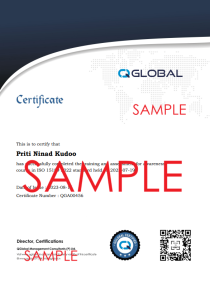BRC Food Safety Standard Issue 9 - Internal Auditor Course
- Description
- Curriculum

The BRC Global Standard for Food Safety is developed by food industry experts from retailers, manufacturers and food service organizations to ensure it is rigorous and detailed, yet easy to understand. First published in 1998, the BRC Food Safety Standard is well-established globally. It has evolved with input from many leading global businesses. BRC Food Safety Standard provides a framework to manage product safety, integrity, legality and quality, and the operational controls for these criteria in the food manufacturing industry. BRC internal auditor course will help you learn how to initiate an audit, prepare and conduct audit activities, compile and distribute audit reports and complete follow-up activities. On successful completion of this course, you will be able to optimize your auditing skills with the internationally recognized BRC food safety standard and boost your audit capabilities. Also gain confidence in planning and performing an effective audit, as well as reporting and taking corrective action where necessary. BRC internal auditor training course develops the necessary skills to assess and report on the conformance and implementation of processes based on BRC food safety standards.
Who Should Attend?
- Anyone involved in the planning, implementing, maintaining, supervising or auditing of an BRC food safety management system
- Those who like to handle the role of an BRC internal auditor in an organisation
- Employees of any organisation who wish to audit their organisation’s food safety management system
- Those involved in second party audits such as vendor audits
- Personnel who wish to pursue career as an BRC internal auditor
- Expert advisors in food safety management
Key Benefits
- Gain the skills to plan, conduct, report and follow up first and second party audits in accordance with ISO 19011
- Learn skills to lead an internal audit team
- Identify the aims and benefits of BRC food safety audit
- Interpret BRC requirements for audit application
- Grasp the application of risk-based thinking, leadership and process management
- Acknowledge the correlation between BRC and other standards and regulatory frameworks
- Learn the latest techniques in BRC internal auditing
- Consolidate your expertise with the latest developments and contribute to the continuous improvement of the business
Learning & Evaluation Method
This is a live and interactive course. Once you purchase the course, our team will contact you to plan the training. No matter where you are located, we schedule the classes based on your convenience and time zone. You can plan to attend the training in sessions of 4 or 8 hr duration, based on how much time you can spend in a day.
Certification
There are increasing numbers of organizations, who prefer candidates those who have certain certifications from recognized programs. Certification demonstrates your commitment to superior professionalism, upholding industry standards, and continued learning. These merits can help boost your professional credibility and prestige within your own network, in your organisation, with your current clients, and when pursuing new business opportunities. After the successful completion of the course and final exam, you will be awarded with a certificate of completion issued by QGlobal. Your credentials will be made available in the global online directory and can be verified by anyone searching with the certificate number. Without doubt we can say that our training courses are well recognized and sought after by organizations across various geographies.
Buy for group Are you planning to buy this course for a group? We have the best prices for you! Select ‘Buy for Group’ option and add to the cart. You will get a discount of 60 – 75% for a group of up to 10 participants. To make a group purchase, create your group name and add individual emails of up to 10 participants. Each participant will get the access to the course materials, exam and the certificate. We will arrange one live-online session for the entire group.
Total: 205 Courses View all
-
1Introduction to standards and certification
- Purpose of standardization
- Benefits of certification
-
2Introduction to BRC FOOD SAFETY ISSUE 8
- Benefits of BRC certification
-
3BRC FOOD SAFETY ISSUE 8 Senior Management Commitment
- Senior management commitment and continual improvement
- Organizational structure, responsibilities and management authority
-
4BRC FOOD SAFETY ISSUE 8 The Food Safety Plan
- HACCP food safety team ( Equivalent to codex alimentarius step 1)
- Prerequisite programmesProduct description (Equivalent to codex alimentarius step 2)
- To identify intended use ( Equivalent to codex alimentarius step 3)
- Records of process flow ( Equivalent to codex alimentarius step 4)
- Verification of process flow ( Equivalent to codex alimentarius step 5)
- List of potential hazards associated with each process step, hazard Analysis and measures to control identified hazards (Equivalent to codex Alimentarius step 6)
- Critical control points (Equivalent to codex alimentarius step 7)
- Critical control limits for each CCP (Equivalent to codex alimentarius Step 8)
- Establishing monitoring system for each CCP (Equivalent to codexalimentarius step 9)
- Establish a corrective action plan – Codex Alimentarius Step 10, Principle 5
- Establish verification procedures – Codex Alimentarius Step 11, Principle 6
- HACCP documentation and record keeping – Codex Alimentarius Step 12,Principle 7
- Review the HACCP plan
-
5BRC FOOD SAFETY ISSUE 8 Food safety and quality management system
- Food safety and quality manual
- Document control
- Record completion and maintenance
- Internal audits – Food safety and quality management audits
- Supplier and raw material approval and performance monitoring
- Management of suppliers of raw materials and packaging
- Raw material and packaging acceptance and monitoring
- Procedures
- Management of suppliers of services
- Management of subcontracted, outsourced processing
- Specifications
- Corrective and preventive actions
- Control of non-conforming product
- Traceability
- Complaint handling
- Management of incidents, product withdrawal and product recall
-
6BRC FOOD SAFETY ISSUE 8 Site Standards
- External Standards
- Site Security and Food Defence
- Layout, product flow and segregation
- Building fabric, raw material handling, preparation, processing, packing and storage areas
- Utilities – water, ice, air and other gases
- Equipment
- Maintenance
- Staff facilities
- Chemical and physical product contamination control: raw material handling, preparation, processing, packing and storage areas
- Foreign-body detection and removal equipment
- Housekeeping and hygiene
- Waste/waste disposal
- Management of surplus food and products for animal feed
- Pest management
- Storage facilities
- Dispatch and transport
-
7BRC FOOD SAFETY ISSUE 8 Product Control
- Product design/development
- Product Labelling
- Management of allergens
- Product Authenticity, claims and chain of custody
- Product Packaging
- Product inspection and laboratory testing
- Product Inspection and testing
- Laboratory testing
- Product release
- Pet food
-
8BRC FOOD SAFETY ISSUE 8 Process control
- Controls of operations
- Labelling and Pack Control
- Quantity-weight, volume and number control
- Calibration and control of measuring and monitoring devices
-
9BRC FOOD SAFETY ISSUE 8 Personnel
- Training Raw material handling, preparation, processing, packing and Storage areas
- Personal hygiene Raw material handling, preparation, processing,Packing and storage areas
- Medical screening
- Protective clothing, Employees or visitors to production areas
-
10BRC FOOD SAFETY ISSUE 8 High-risk, high-care and ambient high-care production risk zones
- Layout, product flow and segregation in high-risk, high-care and ambient high-care zones
- Building fabric in high-risk and high-care zones
- Maintenance in high-risk and high-care zones
- Staff facilities for high-risk and high-care zones
- Housekeeping and hygiene in high-risk and high-care zones
- Waste/waste disposal in high-risk, high-care zones
- Protective clothing in high-risk and high-care zones
-
11BRC FOOD SAFETY ISSUE 8 Requirements for traded products
- Approval and performance monitoring of manufactures/packers of Traded food products
- Specifications
- Product Inspection and laboratory testing
- Product legality
- Traceability
-
12Introduction to ISO 19011 2018 Guidelines for auditing management systems
- Scope
- Normative references
- Terms and definitions
-
13ISO 19011 Principles of auditing
-
14ISO 19011 Managing an audit program
- Establishing audit programme objectives
- Determining and evaluating audit programme risks and opportunities
- Establishing the audit programme
- Roles and responsibilities of the individual(s) managing the audit programme
- Competence of individual(s) managing audit programme
- Establishing extent of audit programme
- Determining audit programme resources
- Implementing audit programme
- Defining the objectives, scope and criteria for an individual audit
- Selecting and determining audit methods
- Selecting audit team members
- Assigning responsibility for an individual audit to the audit team leader
- Managing audit programme results
- Managing and maintaining audit programme records
- Monitoring audit programme
- Reviewing and improving audit programme
-
15ISO 19011 Conducting an audit
- Initiating audit
- Establishing contact with auditee
- Determining feasibility of audit
- Preparing audit activities
- Performing review of documented information
- Audit planning
- Assigning work to audit team
- Preparing documented information for audit
- Conducting audit activities
- Assigning roles and responsibilities of guides and observers
- Conducting opening meeting
- Communicating during audit
- Audit information availability and access
- Reviewing documented information while conducting audit
- Collecting and verifying information
- Generating audit findings
- Determining audit conclusions
- Conducting closing meeting
- Preparing and distributing audit report
- Preparing audit report
- Distributing audit report
- Completing audit
- Conducting audit follow-up
-
16ISO 19011 Competence and evaluation of auditors
- Determining auditor competence
- Personal behavior
- Knowledge and skills
- Achieving auditor competence
- Achieving audit team leader competence
- Establishing auditor evaluation criteria
- Selecting appropriate auditor evaluation method
- Conducting auditor evaluation
- Maintaining and improving auditor competence
-
17ISO 19011 Audit role plays















































